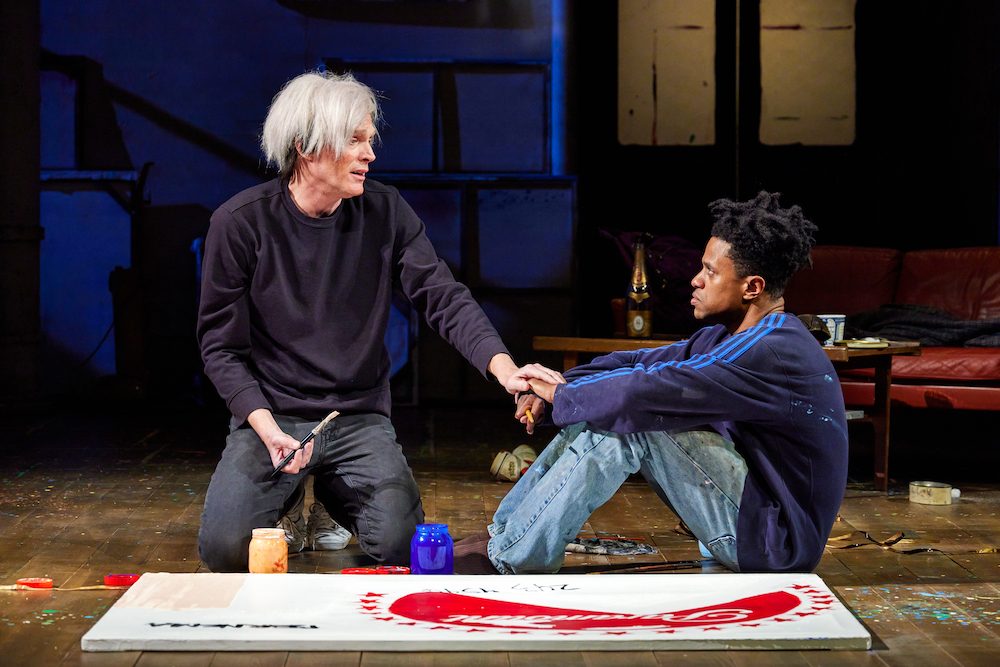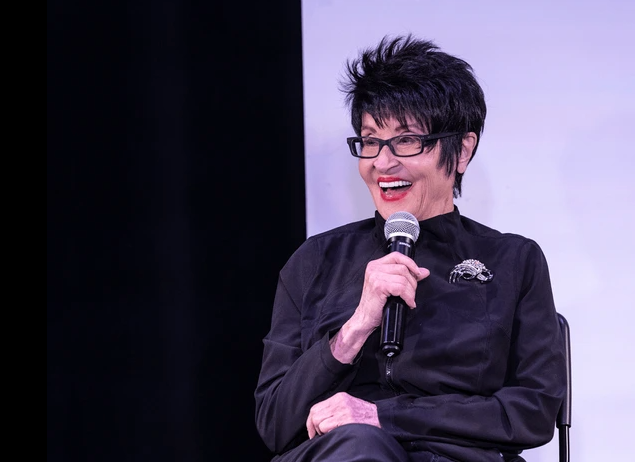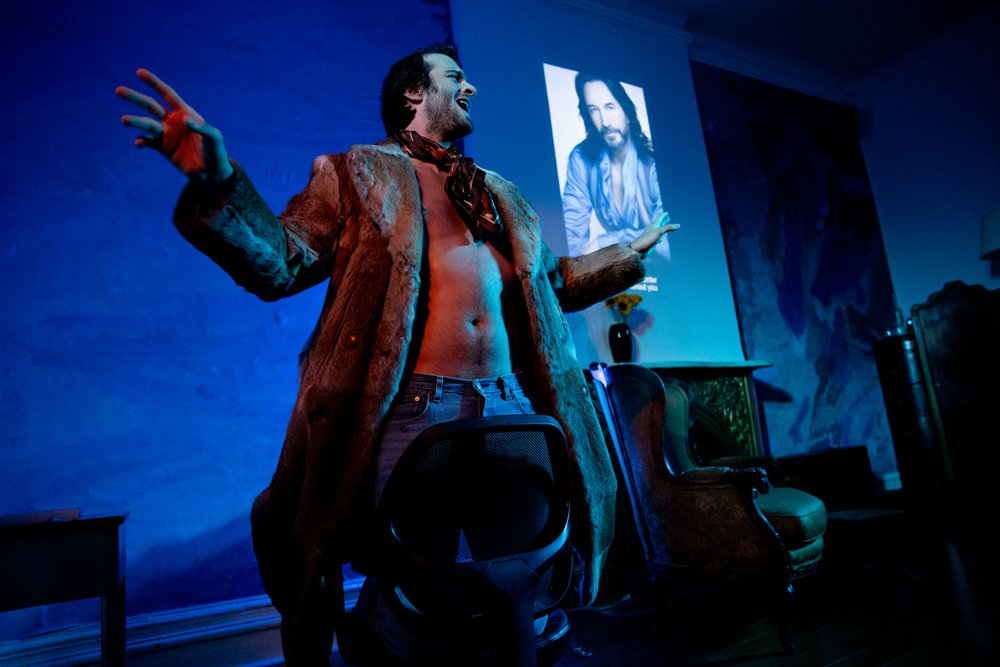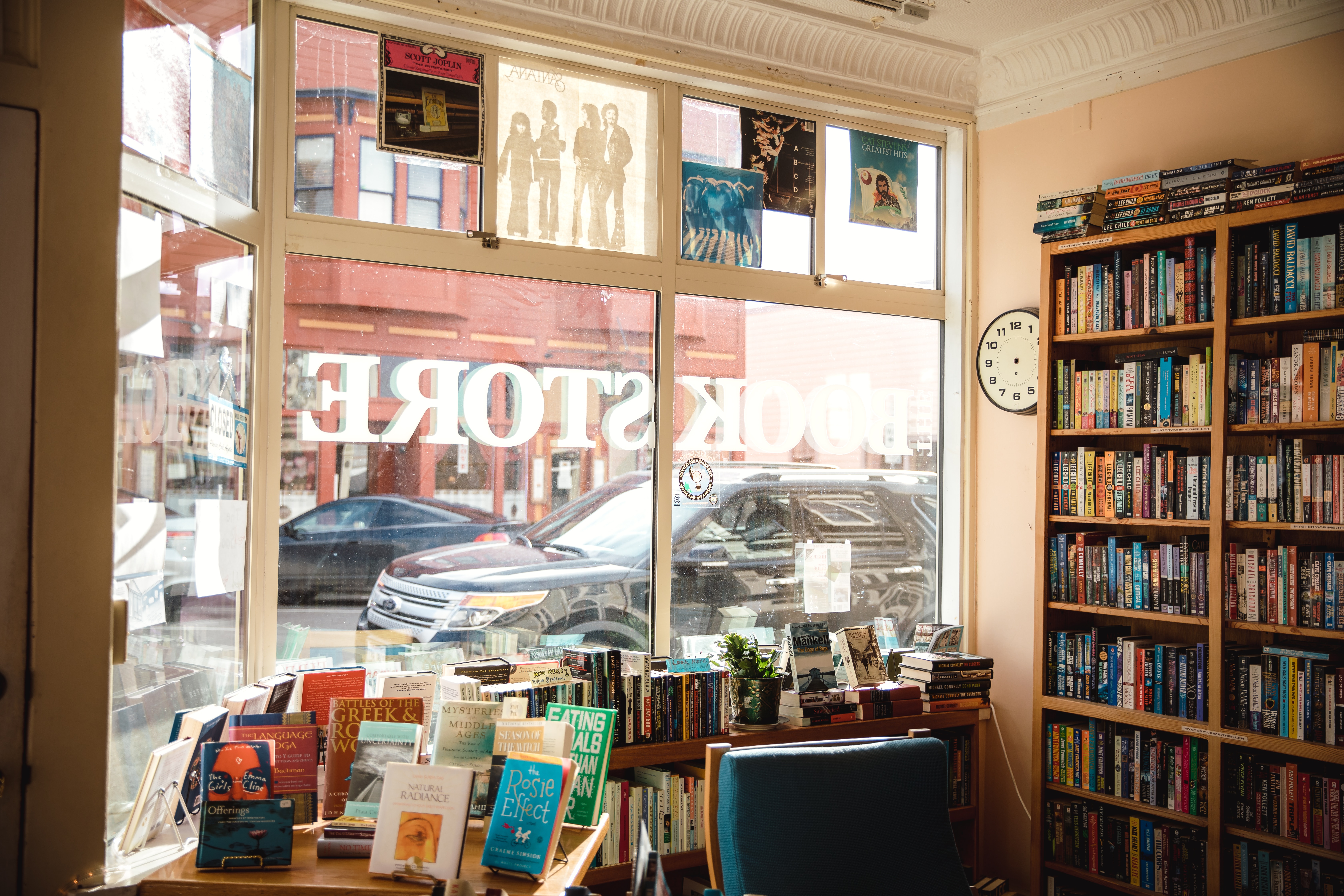
I’m not sure what I was expecting when I was given the chance to see The Collaboration. How could any actor nail down the persona of an eccentric? The more I anticipated the performance, the more I thought about how the task seemed Herculean, almost. Something akin to, “here – screw this patch of kinetic sand to the wall real quick.”
The Collaboration centers on a time in history when Andy Warhol and Jean Michel Basquiat worked together on a project. My experience has been that Warhol and Basquiat are either seen as artistic geniuses or con artists. There’s no in between. Their work is iconic and deeply respected by many New Yorkers. Far more people, however, just don’t get it. Right before the performance, I read a post in which someone called Andy Warhol the “greatest copy and paste master of his time.” Gulp. I haven’t conducted a study, but I’d venture to say that deep down most people feel that way about modern art. Everything in our American minds boils down to money and capital. If you have any kind of foothold in reality, at least part of you has to wonder, while strolling through the Basquiat exhibit in Chelsea, “why are these child-like doodles worth millions of dollars?”
So, yeah. Paul Bettany and Jeremy Pope had all of that to contend with, and for some reason I was nervous for them. However, I had not yet known about the acting chops of Paul Bettany and Jeremy Pope. I don’t watch television too much.
My biggest gripe about the recent Basquiat exhibit is that there was no entry point for newbies. You look at a lot of paintings and art work of his and you have to pretend to get it immediately, or else you’re the worst. The Collaboration on the other hand found a “way in” that works for everyone: funky eighties beats.

Before the show even begins audience members are treated to a live, enthusiastic DJ whose set list includes all the great hits of the era. This is likely the only performance in which you’ll see people shimmy shake their way to their seats. The music makes even the most nightclub adverse grandma (in this case, me) suddenly long for a night out full of laser ray sound effects floating over a good beat and shiny disco balls. Footage from the bad old days plays out on a projector and one quickly gets the sense that this is going to be a gritty, fun, to do.
From the start of the play, there’s a welcomed relief for those people mentioned above who have one foot in reality. There’s a steady stream of criticism, sarcasm, and joking about both Warhol and Basquiat’s respective art forms. Neither one seems to “get” what the other is all about and almost immediately we are exposed to a very human side of men who often are treated as cultural demigods. Enter: Jealousy. Discomfort with change. Fear in being irrelevant. Frustration in being misunderstood. And dare I use the phrase…imposter syndrome.
I think the best part of Bettany’s performance came not just from his ability to make Warhol’s vulnerability visceral, or his moments of anger unsettling. There’s this quirkiness to Warhol, and it’s not forced or contrived. He seems, at least in Bettany’s portrayal, totally oblivious to the humor that is elicited from his way of thinking and speaking without much forethought in how his words will land. There’s a gut wrenching innocence in his candor that kind of makes you adore him. This is in spite of the fact that we’re kind of jealous that we all have to work jobs we hate and Warhol was living large from reproducing Coke bottles.

However you might feel about Warhol as an artist, Bettany’s portrayal of him has made clear that the world is losing their eccentrics. Maybe they’re all leaving the art scene and moving into the tech sector, but still. The outward artistic identity that we see nowadays in places like Bushwick for instance feels manufactured. Artists are trying too hard to be like Warhol’s soup cans (carbon copied) and less like the best parts of Warhol himself. In the day and age where everything finds its way to the masses by internet for ridicule, (something Warhol Ala Bettany touches on and says is inevitable) there’s a real fear in truly letting one’s freak flag fly.
But when you watch Jeremy Pope’s portrayal of Basquiat in the second act of the play, that fear is not exactly unfounded. At the depths of who we really are could be a really scary place to find ourselves.
If you’ve never seen someone go past their limit, and then run, nay, sprint even further past their limit, then you’re going to feel disturbed here.
There’s a heartbreaking inability for Basquiat to stop. His mind, emotions, unresolved trauma, body and speech all seem to constantly be firing on all cylinders. There’s not stillness and he seems to always be running from something. It’s heartbreaking to make the realization that the something is himself.
Pope springing about the stage embodying Basquiat stirs a range of emotions. For one, I felt that the curtain was peeled back and I was finally let in on who Basquiat was.
For instance, most people know that Basquiat was hit by a car and underwent a ton of surgery and treatment. However, this was the first time I learned how specifically that impacted his artistic persona. Following the accident, Basquiat engaged in the kind of magical thinking (that all children do) and deduced that drawing body parts is what helped heal him when the odds of a fully recovery were very uncertain. Body parts and gory images became a staple in his work over the years, and he never quite let go of that magic way of thinking. This is especially interesting considering that he’s half Haitian, a culture in which many believe in Vodou.
In the play, Basquiat’s friend is severely hurt from a police beating and is hospitalized. Basquiat believes that he can heal his friend by creating a painting for him. Warhol disrupts his creative process, and the pair soon after hear that the friend passed away. Basquiat is absolutely animate that Warhol not allowing him to finish the painting is what killed his friend. Magical thinking. This type of in depth understanding on the impact that trauma had in Basquiat’s life and work was very much appreciated.
Naively, I waited in vain for some feel good moment where Basquiat throws his heroin needle to the side and starts anew. Instead, we’re left with the unsettling feeling that this rabbit hole which Basquiat has tumbled down (comprised of drug use, mental health issues, and trauma) likely has no end. He’s suspended in an alternate reality which none of us mere mortals can access. It’s something that seems to frustrate him increasingly and leaves those in his life who love him equally as frustrated.

The play leaves off with no real hints about what Basquiat nor Warhol’s futures hold, neither as individual artists or a team. There’s a burst of hope at the very end, as Basquiat seems to dream about the fortunes and fame that the collaboration with Warhol will bring. But knowing the actual fate of both men in real life, that hope is quickly extinguished.
There’s no satisfaction that comes with learning that Basquiat and Warhol were as tortured as any of the rest of us, both with a heap of unresolved trauma to boot. There is, however, a profound sense of gratitude for the attempt to help us understand how their brains worked. There’s a sense of empathy that is evoked for the men. This is especially true if your preconceived ideas about the pair were lingering with resentment about how much undo praise their work renders. To be any kind of flavor of neuro-diverse person is an exhausting experience. Reality literally looks different which can be lonely and isolating. I don’t think there’s any amount of money or famous friends that can fix that. I think accepting those who are neuro diverse, and doing it well, is our next great challenge as a society.
A huge bravo to Paul Bettany and Jeremy Pope for bringing depth and clarity surrounding Andy Warhol and Jean Michel Basquiat. This play will sit with you for a long time.
Performances last until February 5th.





